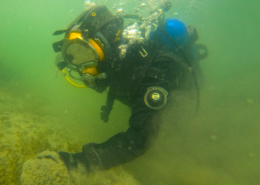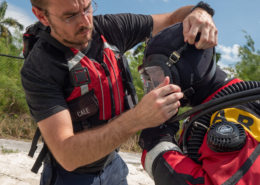How to Simulate Blacked Out Water Training
By: Thomas Powell
In the modern dive community, every type of diving has inherent risks. The reality is that every little niche within scuba diving will always have supporters who will claim that their type of diving is the “coolest, toughest, most interesting, or most exotic.” No matter what type of dive you perform, we all undergo training and gather experience in order to improve our knowledge, muscle memory, and general safety. The public safety diving community is one of these niche groups within scuba diving. The primary difference between public safety divers and others is that public safety divers rarely enter the water for enjoyment. Instead, they prepare for the worst so they can serve their communities in times of need. The majority of their dives are performed in less than ideal conditions in places where bad guys realize evidence would be difficult to find. This type of diving can affect any diver’s mental state which makes training essential. Worry, fear, bravado, and desperation must all be overcome to remain safe while trying to provide service and care to others.
Evidentiary items are often tossed away into filthy bodies of water in the hopes that law enforcement will never be able to perform an effective recovery.
These waters may have low levels of visibility, contaminates, obstructions, and various other problematic factors. In turbid black water, visibility may get so low that adding light is like turning on high beam headlights in the fog. Only muck and particulates are illuminated. A diver’s ability to see does not improve. So how do you train for a situation in which you cannot see? Over the years, many methods have been developed.
First it must be recognized that many dive teams begin training and are developed during a period when equipment is being purchased or gathered. This factor means that newer divers are used to half-masks and have not yet moved on to full-face systems. To begin preparing for black water environments, these standard half-masks must be covered. This action can be accomplished by purchasing manufactured mask covers, or simply by covering the outer mask lens/es with something such as duct tape. If the mask can be applied to the face and no light enters, the mask is ready for training use.
Similar to half-masks, full-face masks must be prepared for black water training once a team is prepared and trained in the proper use of full-face systems. Like half-masks, certain manufacturers make covers for full-face masks. Despite this, items such as mask covers may be viewed as costly with already-tight team budgets. For this reason, many teams have learned to tape lenses in a similar fashion to half-masks, or to stuff the airspace inside masks with dark substances such as black plastic.
Methods used must not deteriorate the comfort of the divers.
No matter how a team decides to eliminate visibility in masks used for training, the methods used must not deteriorate the comfort of the divers other than to eliminate visibility. Anything protruding into the face, interfering with a seal, or disrupting the actions of a dive could cause an unneeded and avoidable safety concern. Once methods are determined and safety is evaluated, the first step is to begin the training process in a confined water environment. Teams must take the time to perform search patterns, practice line pulls, simulate procedures, and perform emergency simulations in an environment where support can be offered, actions can be reviewed, and safety can be verified. A location such as a pool will allow team members to perform patterns and actions where safety divers can be readily available, and the surface can be easily reached. Skills should be performed in this type of environment until team members can perform standard operational tasks, search patterns, tactile searches, find tools and cutting devices, switch to backup gas systems, and recover from problematic situations.
Similarly, tenders and shore personnel should take the time to monitor how actions are performed and recognize how they can support and assist other team members based on specific needs while activities are visible. Remember that in black water, the diver depends on his or her tender for support, survival, and direction. Tenders and other surface personnel must be trained and practiced in providing oversight and direction to a diver on the end of a tether. Line pulls, communication-based commands, responses to stress, and reactionary commands must be practiced until they are fluid and performed with immediate recognition.
When a diver first loses the ability to see, he or she often retracts into his or her mental world.
Fear can take control and it is often up to the tender to provide the calming voice and mental support. Recognizing stressed breathing or erratic behavior is an important part of the training process. Once a diver and tender can operate in support of one-another, a strong bond will have been developed that can transfer to an open water operation. This bond will help a diver learn to focus his or her mental activity on operational goals. The diver can begin to work on maintaining a tight search pattern, feeling for the item he or she visualizes in his or her mind. Essentially, team work can help a dive team focus on the missions it performs.
Once team members are comfortable in a confined water environment, practice must be moved into a realistic setting. The first objective should be to perform similar actions and tasks in a known open water location. This step will allow divers to begin to adapt to a realistic operational environment. The same basic skills performed in the pool can now be performed in open water. As comfort is established, the team can develop full operational scenarios to see how all members function when divers do not have the ability to see while performing searches. In an open water environment, the tender may no longer be able to see the diver other than bubbles and where the tether enters the water. In contrast, the diver now relies on the tender to recognize the pattern and position in an environment that is no longer a simple swimming pool. The teamwork built in confined water can help divers and tenders work together in an effective fashion. Similarly, potential problems can be recognized, evaluated, and corrected as needed.
Aside from learning to operate in black water environments, other extreme realities must be faced.
Many teams get comfortable in full-face systems and as with anything, emergency skills begin to fade. This factor suggests that divers must take the time to practice bailout procedures when all visibility is lost. Again, this is a task that can first be performed in the pool, and then transferred to a controlled open water setting. Basic skill sets cannot be allowed to deteriorate while establishing comfort in tough environments. As we move forward in education, we must all remember to return to return to the basics in periodic cycles. We do not want to learn new things while forgetting what we have already learned. As a dive team member, use new education to build your educational background and work to become a better diver. The objective is to be safe and go home after every dive, not to simply build a larger stack of credentials. To be able to help your community as a public safety diver, you must stick around and grow experience, not be lost to ego and a lack of basic skills practice.
- Thomas Powell Owner/Instructor Trainer – Air Hogs Scuba, Clayton, NC – Cave Excursions, Live Oak, FL




 Y. ZIN
Y. ZIN




Skriv en kommentar
Vil du deltage i diskussionen ?Du er velkommen til at bidrage !